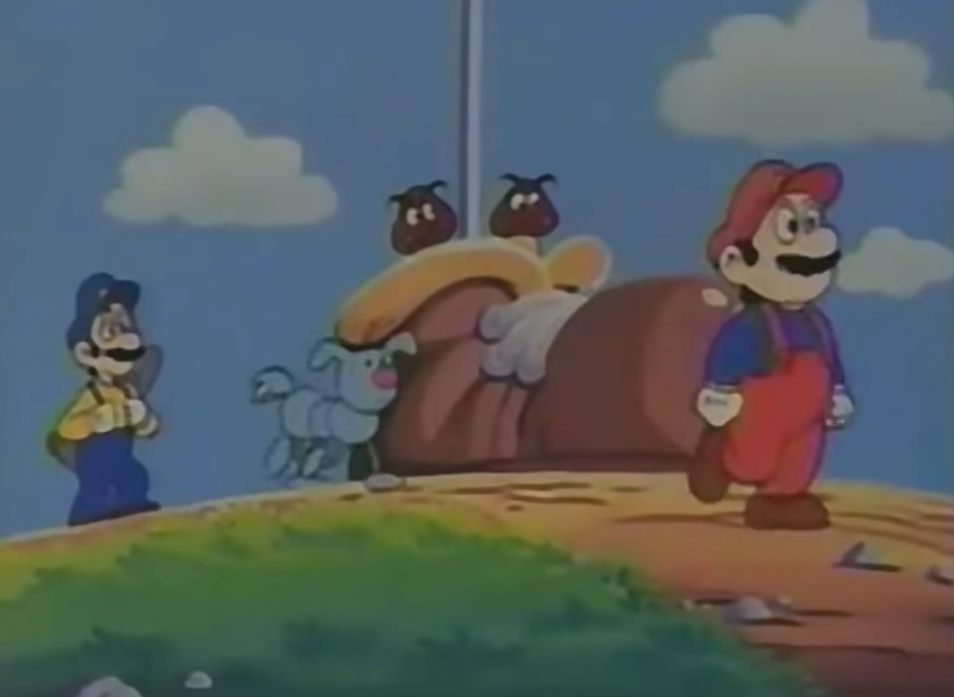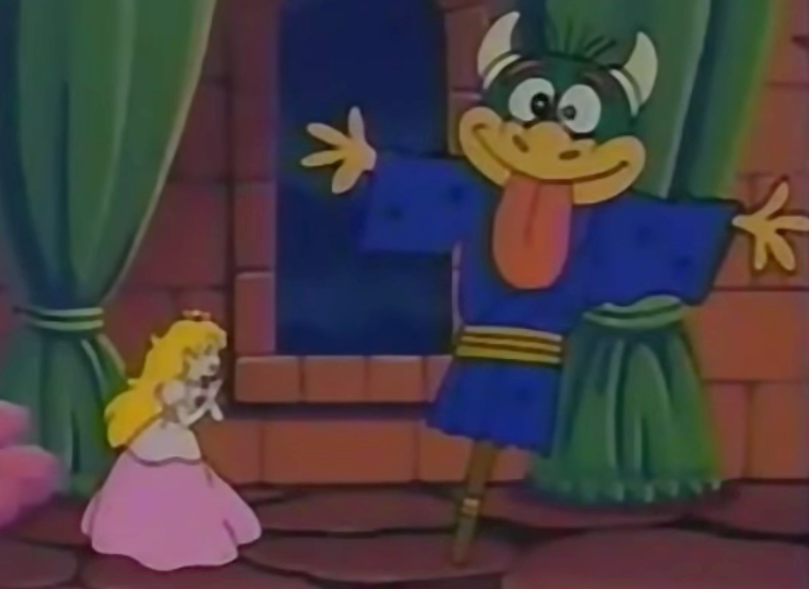First up, we might as well fix that lack of international exposure right now. It’s fairly simple to find it online, and you even watch it right here.
It’s only an hour long. According to the Mario Wiki, it was paired in theaters with a video guide to playing the Japanese version of Super Mario Bros. 2, the game we know in the U.S. as The Lost Levels. The game came out just a few weeks before the movie.
Watching the movie for the first time this week, I thought it was interesting how many details from the movie ended up working their way into the games. Some of it’s coincidence, I’m sure; the movie-makers were just exploring ideas that the game designers eventually would have had regardless. But some of them seem pretty spot-on. Today, I’m listing these off, as well as a handful of concepts that Nintendo maybe should have thought about incorporating.
For example, that same Mario Wiki article points out that the movie has a sequence where Luigi has a bad trip after eating the wrong kind of mushrooms. The scene could be a reference to the fact that The Lost Levels introduced nasty, trick mushrooms that hurt you instead of powering you up.
It seems plausible, even if it just makes me wonder how an eight-bit, pixelated psychedelic freak out might look.
The movie also features a scene where Mario and Luigi escape on a flying ship, years before the Super Mario Bros. 3 came out made airships a staple of the series.
When Mario and Luigi meet Lakitu, Mario ends up stealing Lakitu’s cloud and buzzing around the sky in it. That’s something that Nintendo eventually implemented in Super Mario World — and again now that Lakitu is a playable character in the Mario Kart games and you can stick anyone you want in his little cloudmobile.
In the movie’s climatic fight, Mario beats Bowser by grabbing him by the tail and then spinning-tossing him into the horizon in the style of an Olympic discus-thrower.
That’s remarkably similar to how Mario dispatches Bowser in Super Mario 64.
Again, that might just be an obvious way to excuse a giant turtle monster from your presence, but to me, this one in particular seems one of the most likely to be intentional among all the similarities between the movie and later games.
The game even has gargantuan versions of the typical Mario baddies — the very kind that got their own series of levels in Super Mario Bros. 3.
An odder coincidence, perhaps? These Goombas standing in this oversized boot. It could be nothing, of course, but the Nintendo fan in me really wants to connect them to the “Kuribo’s Shoe” Goombas from Super Mario Bros. 3.
The Mario Wiki even points out how Luigi’s off-model color scheme — dark blue with yellow, as opposed to the traditional dark blue with green he has in official art or the white and green his original Super Mario Bros. sprite has — gets a nod in the new Smash Bros. game as one of Luigi’s palette swaps.
There’s even an odd scene where Bowser, in an effort to calm the captive Princess Peach, transforms into a scarecrow. That may mean something more in Japan than it does in the U.S., but to me that seems like an awfully specifically thing to turn into… especially since it was something Bowser and the other playable characters in Super Mario RPG could get transformed into.
I’ve never seen scarecrow transformation as a negative status effect in any other video game. Is that, like, a problem in Japan? An epidemic of people turning into scarecrows?
Perhaps the one aspect to The Great Mission to Rescue Princess Peach! that most gets my attention is Peach herself. Unless I’m mistaken, it’s this movie that made the princess look the way she looks today. Check out how she is drawn on box art for the Japanese release of Super Mario Bros.
The feline eyes are there, but everything else looks different — darker hair, a dress that looks like jammies and altogether a cruder look then she’d eventually get. In promotional art for The Lost Levels, Peach looked a lot closer to how she looks today, save for those dimples on her cheeks, which read as pimples in both the Super Mario Bros. and Lost Levels art. The dress is about right, the Farrah flips are in place, she’s a banana blonde, and she’s even sporting her trademark brooch.
She looks much more like this Lost Levels version in the movie.
Well, she’s not wearing a butt on her head in the games, but you can see the resemblance, literal asshat notwithstanding. “But Drew, surely then it was the Nintendo artwork that finalized Peach’s appearance and not this non-canon movie. You are dumb!” But no! And also shut up! I’d suggest it might actually be the other way around. Do you know how long it takes to make an animated feature? Even an hour-long one? If the movie hit theaters juts a few weeks after The Lost Levels started selling in Japan, I’d say that someone had to decide beforehand how Peach was going to look. Maybe it was the animators at Toei. Maybe it was Nintendo giving notes to the animators. But either way, I think it was the movie that determined her appearance in a way that’s stuck for nearly thirty years.
Of course, some of the film’s original bits didn’t carry haven’t yet found a place in the Marioverse proper.
First up, them backgrounds. Back before Nintendo decided that every bush, rock and cloud needed an eerily grinning face on it, Super Mario Bros. skewed more surreal than saccharine. The game includes a few montages where you see vast expanses of the Mushroom Kingdom as it’s navigated by Mario, Luigi and Kibidango, their little canine friend with the weirdly ant-like body.
(Yes, it’s weird that the same song plays so often in a movie that’s only an hour long. Certain creative decisions were made, clearly.)
Maybe it’s the quality of the transfer, but the colors in these backgrounds look less saturated that the bright greens and cyans that defined Super Mario Bros. for a long time, and in an unexpected way, it lends the film a slightly less child-like feel. Eventually, Nintendo would come around to a degree, but it’s notable to see the Mushroom Kingdom look large, alien, and a little imposing instead of just Candyland-esque.
Speaking of Mario’s dog-like companion, Kibidango, who’s apparently named after a type of Japanese dumpling, failed to affect the series mythos in any direct way. It took until Super Mario World for Mario to get an animal buddy (Yoshi), and until Yoshi’s Island for Mario to meet a canine friend (the peculiarly nose-less Poochy). At the end of the movie, however, Kibidango transforms into Peach’s true love, dandy Prince Haru of Flower Kingdom, who was in search of the owner of the other half of his magical brooch when he was turned into a dog… ant… thing.
Haru may seem foppish, but at the end of the movie, everyone seems to agree that he’s a better match for Peach than the portly plumber is, and Mario sets off with only a kiss on the nose for his troubles. It’s probably a stretch, but you could say that there’s an echo of Prince Haru in Yoshi’s Safari, a Super NES shooting game that had Peach asking Mario to rescue the monarchs of a neighboring kingdom. The younger of the two — Prince Pine, whose Japanese name is a reference to pineapples and not pine trees, I'm just learning — has some vague similarities to Prince Haru, but the greatest of them is the fact that he’s a male monarch needing Mario’s help.
There’s also a debatable similarity in Princess Shokora, the damsel Wario rescues in Wario Land Advance. Her appearance varies according to how much money Wario earns over the course of the game, and her “most expensive” form is rather boyish — and not unlike Haru, who maybe looks a little girlish.
And sort of similar to the way that Haru spends most of the movie as a dog, Shokora spends much of Wario Land Advance trailing Wario in the form of a little black cat.
In the “Lady Toad” post, I mentioned how Toad became a playable character in the American Super Mario Bros. 2 almost by default. He wasn’t named in the first game, and Nintendo simply needed a fourth character to round out the roster. Hypothetically speaking, had Nintendo brought The Great Mission to Rescue Princess Peach out in the U.S. and had Americans been familiar with the characters, it wouldn’t have been unthinkable that ol’ Haru might have gotten that fourth slot. You’d have had the two brothers and the two royal lovebirds, and today this dandy prince would be a staple of the series.
Just conjecturing, but it wouldn’t be unthinkable.
The game’s other original character is a kooky pile of beard hairs simply called the Mushroom Mystic. There’s nothing close to him in any of the games, by why shouldn’t there be? Perhaps we’d all like playing as a white pushbroom of an old man.
I have one final creative choice in The Great Mission to Rescue Princess Peach! that Mario lifers might be interested to know about. In the movie, Mario and Luigi aren’t plumbers, like there are in the American version of the games, or carpenters, like Mario was in Donkey Kong. They’re grocers. That’s… maybe an aspect to Mario’s mystique we could do without.
(Note: There’s also now a part three in this little series, if you’re interested.)
















No comments:
Post a Comment